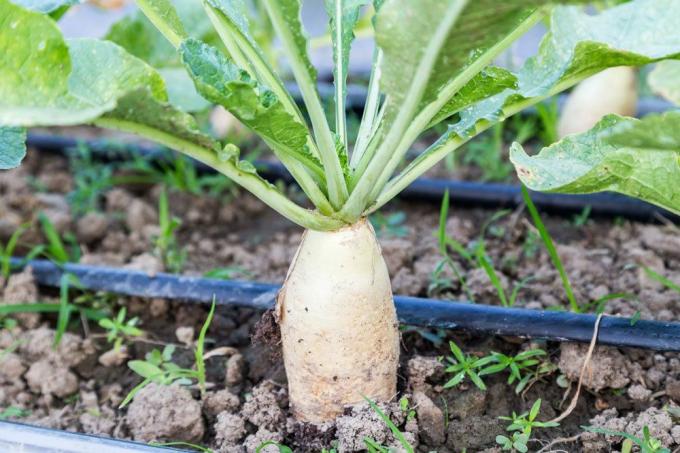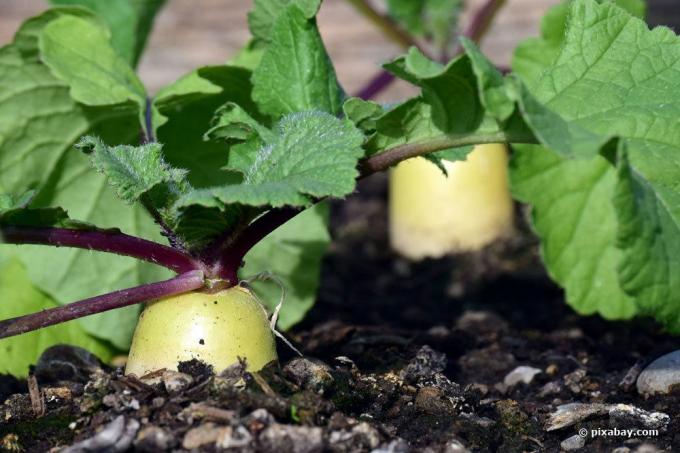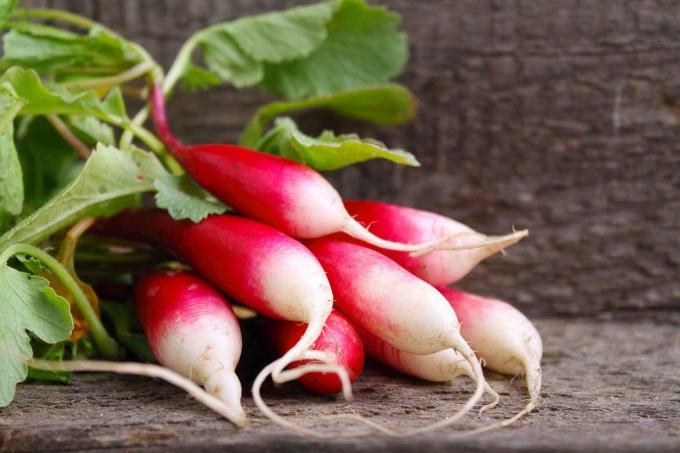
table of contents
- Radish shoots into the herb
- Variety choice
- cold
- warmth
- Lighting conditions
- Nutrient supply
- Harvest time
- Dispose of unusable radish plants
The green foliage of the radish should ensure that a large, tasty root forms in the soil. But a lot of foliage does not bring a good harvest for a long time. On the contrary: when radish shoots into the herb and perhaps even blooms, the root growth is suddenly over. Instead of constantly increasing in size, the beet remains spindly. Why is it that radishes develop like this? And what can you do about it?
Radish shoots into the herb
If at the radish plant, bot. Raphanus, excessive foliage is detected, it is no longer possible to reverse the growth. Digging up a specimen reveals what actually bothers us: the lack of an edible root. Can the radish plant now be stimulated to use its energy for the underground part from now on? Will she still please us with a delicious turnip? Unfortunately, no. Edible radishes can now only be obtained by re-sowing at the appropriate time. However, if the causes of the excessive growth are not discovered and eliminated, the problem can recur.
A common problem
It is not so rare that Raphanus, including the subspecies radishes, shoots up sharply and neglects the development of the roots. Inexperienced gardeners in particular report disappointedly about this phenomenon. So it makes sense to look for the reasons in the cultivation. The unpredictable weather could also be responsible. Let's take a closer look at where something could have gone wrong or how it can run optimally in the future.
Variety choice
Radishes can be sown twice a year: in spring and in late summer. In doing so, however, one must not indiscriminately reach for one of the commercially available varieties. Because not all radish varieties are suitable for both sowing dates at the same time. If the variety and the time of cultivation do not harmonize, the radish can shoot into the herb. Radish varieties are divided into these two categories:
- Spring and summer radishes
- Autumn and winter radishes

tip: When the radish shoots into the herb and flowers, it forms seeds soon after. If these seeds are used for later sowing, hobby gardeners often complain about the result. Be on the safe side, in such a case it is better to buy fresh seeds from the garden center.
cold
The first period for sowing extends from April to early August. However, many radish lovers sow this hot root as early as March or even February. Often the driving forces behind it are impatience, ignorance or simply the hope that it will somehow work out. It can actually work if the weather cooperates. It has to be mild for this, with constant temperatures above 10 ° C. But in our latitudes rather the opposite is the case. Unexpected night frosts can occur until mid-May.
- long cold spells during germination are unfavorable
- the soil temperature is crucial
- it should not fall below 10 ° C for more than ten days
- otherwise later growth disorders are promoted
- the “supercooled” radish shoots up and blooms
- the hoped-for beets, on the other hand, are not produced
warmth
Warmth can also encourage the Raphanus to grow abundantly above ground. This ties up all of its energy, so the beet remains in the development stage. The weather will always be a matter of luck, but we don't have to challenge luck.
- do not sow too late in spring
- if it is already too warm, better go without it
- sow in summer from the beginning of July to the end of August
- however, pay attention to the current weather
- possibly. Move the sowing date backwards
tip: However, the radish must not be sown too late, otherwise the beets will not have enough time to ripen. Early frosts set a time limit here.
Lighting conditions
If the radish is late or late in spring. If sown early in autumn, long, bright days await him. However, this high light intensity will accelerate the above-ground budding. What can be done to avoid this situation, apart from coordinating the sowing date even more carefully? You could also plant the radish a little more shady. It must not be completely shaded, but penumbra is perfectly acceptable.
Nutrient supply
The radish belongs to the middle eater. He doesn't need a lot of nutrients. And if he gets them in excess, he uses them to drive them out strongly. If it is only subsequently established that the soil is too rich in nutrients, there is little room for maneuver. Radishes that are still small could be transplanted to a cheaper place. Otherwise all that remains is to pay attention to this aspect in good time in the future. A modest fertilization four weeks before sowing is sufficient.
Harvest time
Raphanus sown in spring takes about 8 to 10 weeks to be ready for harvest. Winter radish takes a little longer, namely 13 to 15 weeks. But then it has to be quick. Especially in summer, the time window for harvesting is often no more than a week. Then the radish shoots into the herb and flowers. In this case, strong radishes have developed, but they have now become furry and woody. What can be done to prevent this loss of quality? The following is possible:
- act before the calculated harvest date
- regularly check the ripeness of the radishes
- Find out when it is ready to be enjoyed by tasting it
- rather harvest a little earlier
- Store unused beets
- Spring radishes stay fresh in the refrigerator for three days
- Autumn and winter radishes can be stored for weeks

tip: Dig or expose a radish beet. When you squeeze your thumb and forefinger, the beet must not give way, otherwise it is already overripe.
Dispose of unusable radish plants
Radish plants shot in the herb, where it is clear that the harvest is irretrievably lost, can be removed from the bed. This means that no further nutrients are extracted from the soil. In addition, the useless seed formation is prevented. The space that has become free can be used for growing other vegetables in the same season.
